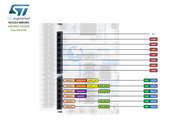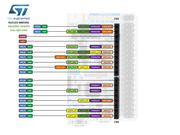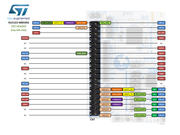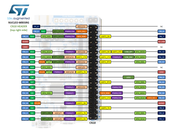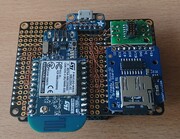Board Support Package for the Nucleo STM32WB Board
Intro
The board support package for the STM32WB Nucleo Board is restricted to the Arduino UNO R3 pin header and the onboard LEDs and switches (buttons). The STM32 has much more capabilities then 14 digital I/O pins, 6 analog input pins, UART, SPI, and I2C interfaces. But if you want to use the more advanced features you can use the CubeMX to create source code for the internal peripherals. This project wants to show how to use the Cube Ecosystem for a Forth system (or vice versa) and can't implement all features and possibilities the STM32WB has. It is a good starting point for your project.
This page is no longer updated regularly, the current documentation can be found at
GitHub .
.
Board Support Words
Defaults: Digital port pins D0 to D7 are push pull outputs, D8 to D15 are inputs with pull-up resistors.
led1! ( ? -- ) set LED1 (blue)
led2! ( ? -- ) set LED2 (green)
led3! ( ? -- ) set LED3 (red)
led1@ ( -- ? ) get LED1 (blue)
led2@ ( -- ? ) get LED2 (green)
led3@ ( -- ? ) get LED3 (red)
switch1? ( -- ? ) get switch1, closed=TRUE
switch2? ( -- ? ) get switch2, closed=TRUE
switch3? ( -- ? ) get switch3, closed=TRUE
dport! ( n -- ) set the digital output port (D0=bit0 .. D15=bit15).
dport@ ( -- n ) get the digital input/output port (D0=bit0 .. D15=bit15).
dpin! ( n a -- ) set the digital output port pin (D0=0 .. D15=15)
dpin@ ( a -- n ) get the digital input/output port pin
dmod ( u a -- ) set the pin mode: 0 in, 1 in pull-up, 2 in pull-down, 3 out push pull, 4 out open drain,
5 out push pull PWM, 6 input capture, 7 output compare, 8 I2C
EXTImod ( u a -- ) set for pin a (D2, D4, D7, D10) the EXTI mode u: 0 rising, 1 falling, 2 both edges, 3 none
EXTIwait ( u a -- ) wait for EXTI interrupt on pin a (D2, D4, D7, D10), timeout u in [ms]
pwmpin! ( u a -- ) set the digital output port pin a (D3=3, D6=6, D9=9) to a PWM value u (0..1000). Default frequency is 1 kHz, TIMER1
pwmprescale ( u -- ) Set the PWM prescale for TIMER1. 32 kHz / prescale, default 32 -> PWM frequency 1 kHz
ICOCprescale ( u -- ) set the input capture / output compare prescale for TIMER2. default 32 -> 32 MHz / 32 = 1 MHz, timer resolution 1 us
ICOCperiod! ( u -- ) set the input capture / output compare (TIMER2) period. default $FFFFFFFF (4'294'967'295).
When the up counter reaches the period, the counter is set to 0.
For prescale 32 the maximum time is about 1 h 11 m
ICOCcount! ( -- u ) set the input capture / output compare counter for TIMER2
ICOCcount@ ( u -- ) get the input capture / output compare counter for TIMER2
ICOCstart ( -- ) start the ICOC period
ICOCstop ( -- ) stop the ICOC period
OCmod ( u a -- ) set for pin a (D0, D1, D5) the Output Compare mode u: 0 frozen, 1 active level on match, 2 inactive level on match,
3 toggle on match, 4 forced active, 5 forced inactive
OCstart ( u a -- ) start the output compare mode for pin a with pulse u
OCstop ( a -- ) stop output compare for pin a
ICstart ( u -- ) start input capture u: 0 rising edge, 1 falling edge, 2 both edges
ICstop ( -- ) stop input capture
waitperiod ( -- ) wait for the end of the TIMER2 period
OCwait ( a -- ) wait for the end of output capture on pin a
ICwait ( u -- u ) wait for the end of input capture with timeout u, returns counter u
apin@ ( a -- u ) get the analog input port pin (A0 .. A5). Returns a 12 bit value (0..4095)
vref@ ( -- u ) get the Vref voltage in mV (rather the VDDA)
vbat@ ( -- u ) get the Vbat voltage in mV
CPUtemp@ ( -- u ) get CPU temperature in degree Celsius
I2Cput ( a # u -- ) put a message with length u (count in bytes) from buffer at a to the I2C slave device u
I2Cget ( a # u -- ) get a message with length u from I2C slave device to buffer at a
I2Cputget ( a #1 #2 u -- ) put a message with length #1 from buffer at a to the I2C slave device u
and get a message with length #2 from device to buffer at a
SPIget ( a # -- ) get a message with length # from SPI slave device to buffer at a
SPIput ( a # -- ) put a message with length # from buffer at a to the SPI slave device
SPIputget ( a #1 #2 -- ) put a message with length #1 from buffer at a to the SPI slave device
and get a message with length #2 from device to buffer at a
SPImutex ( -- a ) get the SPI mutex address
Using the Digital Port Pins (Input and Output)
This example is very similar to the McForth#Knight_Rider program.dport! and dport@ set and get all 16 digital pins (D0 to D15) at once. You have to press the SW1 push button til D0 is set to cancel the operation.
3 0 dmod \ set D0 to Output 3 1 dmod \ set D1 to Output 3 2 dmod \ set D2 to Output 3 3 dmod \ set D3 to Output 3 4 dmod \ set D4 to Output 3 5 dmod \ set D5 to Output 3 6 dmod \ set D6 to Output 3 7 dmod \ set D7 to Output
: left ( -- )
7 0 do
dport@ shl dport!
100 osDelay drop
loop
;
|
: right ( -- )
7 0 do
dport@ shr dport!
100 osDelay drop
loop
;
|
: knightrider ( -- )
1 dport!
begin
left right
switch1? \ or key?
until
0 dport!
;
|
: left ( -- )
7 0 do
1 i dpin!
100 osDelay drop
0 i dpin!
loop
;
|
: right ( -- )
8 1 do
1 8 i - dpin!
100 osDelay drop
0 8 i - dpin!
loop
;
|
: knigthrider ( -- )
begin
left right
switch1?
until
0 0 dpin!
;
|
Using the ADC (Analog Input Pins)
apin@ ( a -- u ) returns the ADC value (12 bit, 0 .. 4095) from one of the analog pins A0 to A5 (0 .. 5). Here I use the A0 to control the delay.
: left ( -- )
7 0 do
1 i dpin!
0 apin@ 10 / osDelay drop \ delay depends on A0
0 i dpin!
loop
;
|
: right ( -- )
8 1 do
1 8 i - dpin!
0 apin@ 10 / osDelay drop \ delay depends on A0
0 8 i - dpin!
loop
;
|
left or right word takes about 125 us, the knightrider loop about 50 us (no osDelay). Pretty fast for my opinion.
CH1 yellow: D0 pinCH2 blue: D1 pin

Using the PWM (Analog Output Pins)
Only three port pins are supported so far. The 16 bit TIMER1 is used for the timebase, time resolution is 1 us (32 MHz SysClk divided by 32). The PWM scale is from 0 (0 % duty cycle) to 1000 (100 % duty cycle), this results in a PWM frequency of 1 kHz. If you need higher PWM frequencies, decrease the divider and/or the scale. PWM port pins: D6 (TIM1CH1), D9 (TIM1CH2), D3 (TIM1CH3) Simple test program to set brightness of a LED on pin D3 with a potentiometer on A0. Default PWM frequency is 1 kHz (prescaler set to 32). You can set the prescale with the wordpwmprescale from 32 kHz (value 1) down to 0.5 Hz (64000).
5 3 dmod \ set D3 to PWM
: pwm ( -- )
begin
0 apin@ 4 / 3 pwmpin!
10 osDelay drop
switch1?
until
;
Using Input Capture and Output Compare
Time Base
Default timer resolution is 1 us. The 32 bit TIMER2 is used as time base for Input Capture / Output Compare. For a 5 s period 5'000'000 cycles are needed. All channels (input capture / output compare) use the same time base.
: period ( -- )
5000000 ICOCperiod! \ 5 s period
ICOCstart
begin
waitperiod
cr .time
key? until
key drop
;
Output Compare
: oc-toggle ( -- )
5000000 ICOCperiod! \ 5 s period
ICOCstart
3 0 OCmod 1000000 0 OCstart \ toggle D0 after 1 s
3 1 OCmod 2000000 1 OCstart \ toggle D1 after 2 s
3 5 OCmod 3000000 5 OCstart \ toggle D5 after 3 s
begin
waitperiod
cr .time
key? until
key drop
;
When you abort (hit any key) the program, the timer still runs and controls the port pins. To stop the port pins:
0 OCstop 1 OCstop 5 OCstopOr change the prescale to make it faster or slower:
1 ICOCprescale
Input Capture
This sample program measures the time between the edges on port A2. if no event occurs within 2 seconds, "timeout" is issued. Hit any key to abort program.
: ic-test ( -- )
6 2 dmod \ input capture on A2
ICOCstart
2 ICstart \ both edges
ICOCcount@ ( -- count )
begin
2000 \ 2 s timeout
ICwait ( -- old-capture capture )
cr
dup 0= if
." timeout" drop
else
dup rot ( -- capture capture old-capture )
- 1000 / . ." ms"
then
key? until
key drop
drop
ICstop
;
Pinouts
STM32WB Nucleo Board
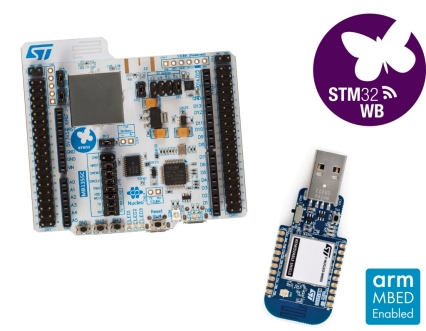
- https://www.st.com/en/evaluation-tools/p-nucleo-wb55.html

- Schematic Nucleo Board MB1355

- Schematic Nucleo Dongle MB1293

Arduino Pinout
Morpho Pinout
Push Buttons
| Signal name | STM32WB55 pin | Comment |
|---|---|---|
| SWITCH1 | PC4 (PC13) | (WKUP2) |
| SWITCH2 | PD0 | |
| SWITCH3 | PD1 |
LEDs
| Signal name | STM32WB55 pin | Comment |
|---|---|---|
| LD1 | PB5 | |
| LD2 | PB0 | |
| LD3 | PB1 | |
| Neopixel | PC12 | D8 |
UART VCP ST-LINK
| Signal name | STM32WB55 pin | Comment |
|---|---|---|
| UART_TX | PB6 | USART1_TX |
| UART_RX | PB7 | USART1_RX |
Quad SPI for Flash
| Signal name | STM32WB55 pin | Comment |
|---|---|---|
| FLASH_NCS | PD3 | QUADSPI_BK1_NCS |
| FLASH_IO0 | PB9 | QUADSPI_BK1_IO0 |
| FLASH_IO1 | PD5 | QUADSPI_BK1_IO1 |
| FLASH_IO2 | PD6 | QUADSPI_BK1_IO2 |
| FLASH_IO3 | PD7 | QUADSPI_BK1_IO3 |
| FLASH_SCLK | PA3 | QUADSPI_BK1_SCLK |
STM32WB Nucleo Dongle
Push Button
| Signal name | STM32WB55 pin | Comment |
|---|---|---|
| SWITCH1 | PC12 | WKUP3 |
LEDs
| Signal name | STM32WB55 pin | Comment |
|---|---|---|
| LD1 | PB5 | |
| LD2 | PB0 | |
| LD3 | PA4 | |
| Neopixel | PC12 | D6 |
Nucleo Dongle - Feather Adaptor
Remove the USB Type A plug from the dongle and add a Adafruit Micro B breakout board. It is convenient to have a Micro-SD breakout board (level shifter is not needed) and JTAG connector (I prefer the 14 pin STM variant to have a serial interface by the ST-LINK). Everything mounted on headers on the backside of FeatherWing Tripler| Description | Dongle | Function | Feather | Micro-SD | JTAG 14pin |
|---|---|---|---|---|---|
| GND | CN1.1 | GND | JP1.13 GND | GND | 5, 7, 11 |
| NRST | CN1.2 | RES | JP1.16 RST | 12 | |
| PA13 | CN1.3 | SWDIO | - | 4 | |
| PA14 | CN1.4 | SWDCLK | - | 6 | |
| PB3 | CN1.5 | SWO | A4? | 8 | |
| 3V3 | CN1.6 | 3V3 | JP1.14/15 3V3 | 3V 5V | 3 |
| PB2 | CN1.7 | SPI_CS | - | CS | |
| PA5 | CN1.8 | D13 SCK | JP1.6 SCK | CLK | |
| PA6 | CN1.9 | D12 MISO | JP1.4 MISO | DO | |
| PA7 | CN1.10 | D11 MOSI | JP1.5 MOSI | DI | |
| PB8 | CN2.1 | D15 SCL | JP3.11 SCL | ||
| PB9 | CN2.2 | D14 SDA | JP3.12 SDA | ||
| PA0 | CN2.3 | A3 | JP1.9 A3 | ||
| PA2 | CN2.4 | D1 | JP1.2 D1 | ||
| PA3 | CN2.5 | D0 | JP1.3 D0 | ||
| PB6 | CN2.6 | UARTRX | 13 | ||
| PA9 | CN2.7 | D9 | JP3.8 D9 | ||
| PB7 | CN2.7 | UARTTX | 14 | ||
| PA8 | CN2.8 | D6 Neopixel | JP3.9 D6 | ||
| GND | CN2.9 | GND | GND | ||
| PA1 | CN2.10 | A2 | JP1.10 A2 | ||
| USB5V | 5V | JP3.3 USB | |||
| BOOT0 | BOOT0 | JP1.1 B0 | |||
| PB0 AT2 ? | JP1.12 A0 | ||||
| PB1 AT2 ? | JP1.11 A1 | ||||
| PB3 ? | CN1.5 | SWO | JP1.8 A4? | 8 | |
| JP1.7 A5 | |||||
| JP3.1 VBAT | |||||
| JP3.2 EN |

This work by Peter Schmid is licensed under a Creative Commons Attribution-ShareAlike 4.0 International License.
| I | Attachment | History | Action | Size | Date | Who | Comment |
|---|---|---|---|---|---|---|---|
| |
TEK0012.png | r1 | manage | 3.6 K | 2020-04-16 - 14:22 | PeterSchmid |
Topic revision: r37 - 2024-02-17 - PeterSchmid
Ideas, requests, problems regarding TWiki? Send feedback
